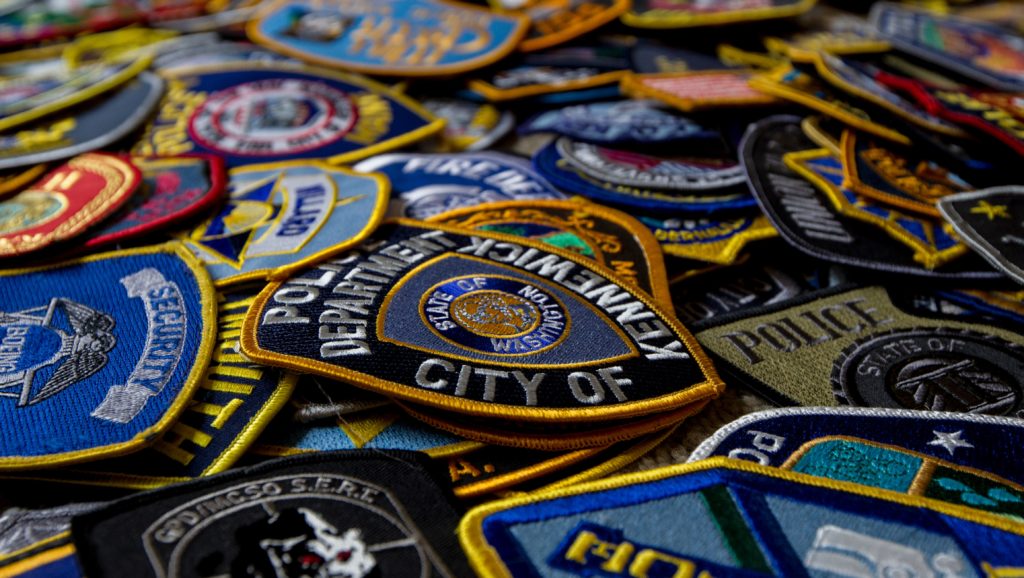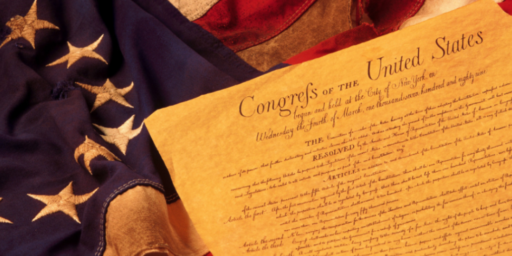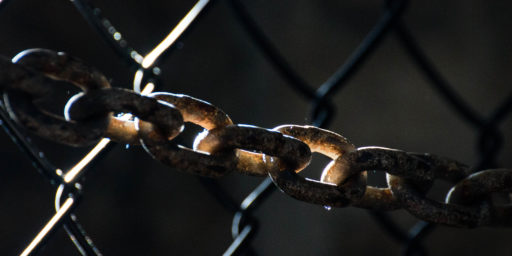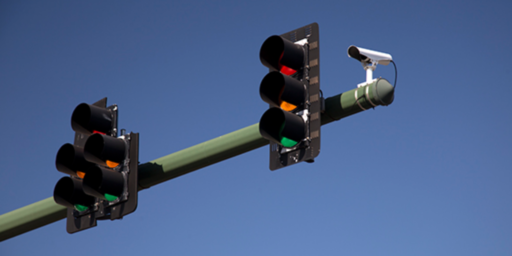Police, Money, and Perverse Incentives
Officers are under enormous pressure--including from the Federal government--to write tickets.

Mike McIntire and Michael H. Keller have an interesting feature in the New York Times titled “The Demand for Money Behind Many Police Traffic Stops.” While much of this is old news, they put it together in a way that shines a light on some overlapping problems. After the requisite anecdote, they report,
A hidden scaffolding of financial incentives underpins the policing of motorists in the United States, encouraging some communities to essentially repurpose armed officers as revenue agents searching for infractions largely unrelated to public safety. As a result, driving is one of the most common daily routines during which people have been shot, Tased, beaten or arrested after minor offenses.
Some of those encounters — like those with Sandra Bland, Walter Scott and Philando Castile — are now notorious and contributed to a national upheaval over race and policing. The New York Times has identified more than 400 others from the past five years in which officers killed unarmed civilians who had not been under pursuit for violent crimes.
It was often noted during the height of last year’s Black Lives Matter protests that Blacks were no more likely than Whites to be killed by police on a per-incident basis. The problem is that, for a variety of reasons, Blacks were much more likely to have encounters with police. And this system is among those reasons.
Fueling the culture of traffic stops is the federal government, which issues over $600 million a year in highway safety grants that subsidize ticket writing. Although federal officials say they do not impose quotas, at least 20 states have evaluated police performance on the number of traffic stops per hour, which critics say contributes to overpolicing and erosion of public trust, particularly among members of certain racial groups.
Many municipalities across the country rely heavily on ticket revenue and court fees to pay for government services, and some maintain outsize police departments to help generate that money, according to a review of hundreds of municipal audit reports, town budgets, court files and state highway records.
That police enforcement of traffic laws is a major revenue source is not new news. But the degree to which this is increasingly relied upon—and to which is funds policing itself—is less well known.
This is, for the most part, not a big-city phenomenon. While Chicago stands out as a large city with a history of collecting millions from motorists, the towns that depend most on such revenue have fewer than 30,000 people. Over 730 municipalities rely on fines and fees for at least 10 percent of their revenue, enough to pay for an entire police force in some small communities, an analysis of census data shows.
A majority are in the South and Midwest, though clusters also appear outside New York City and Washington. They include Henderson, La., a town of about 2,000 people perched along Interstate 10 that collected $1.7 million in fines in 2019 — 89 percent of its general revenues — and where officers were accused of illegally receiving cash rewards for writing tickets. Oliver, Ga., with about 380 residents, gets more than half its budget from fines, but an investigation last year found that the local police had improperly written more than $40,000 in tickets outside their jurisdiction.
In Bratenahl, Ohio, the town government is so dependent on traffic enforcement that the police chief castigated his officers as “badge-wearing slugs” in an email when a downturn in ticket writing jeopardized raises. Ticket revenue helped finance sheriff’s equipment in Amherst County, Va.; a “peace officers annuity and benefit fund” in Doraville, Ga.; and police training in Connecticut, Oklahoma and South Carolina.
“The message goes out that if you want more training, then go ahead and write more traffic tickets,” said Gil Kerlikowske, a former police chief in Seattle and three other cities.
This is, almost surely, an unintended consequence. It’s simply the nature of bureaucracy: governments need metrics to judge the success of programs and to allocate money. Tickets per patrol-hour are an easy way to do both.
To show how a dependence on ticket revenue can shape traffic enforcement, The Times examined the practices of three states — Ohio, Oklahoma and Virginia — where police traffic stops have set off controversy. What emerges is a tangle of conflicts and contradictions that are often unacknowledged or explained away.
Mayors of predominantly white suburbs in Ohio, for example, defended the ticket-blitzing of Black drivers from Cleveland as an acceptable, if unfortunate, side effect of vigorously patrolling brief sections of interstates within their borders.
Some officers in Oklahoma, insistent that public safety is their goal, no longer cite drunken motorists for driving under the influence, and instead issue less-serious tickets that keep the drivers out of district court and generate more money for the town.
And in a small Virginia town last December, just days after the police threatened and pepper-sprayed a Black and Latino Army lieutenant, Caron Nazario, over a license plate infraction — body-camera video released in April would elicit public outrage — elected officials questioned the chief on why ticket revenue was down for the year. He later reminded his officers to issue at least “two tickets per hour” during federally funded patrols.
While there are doubtless a lot of racist cops, they’re likely not targeting Black drivers per se but going to where the history shows they’ll be able to find the most cars in violation. And, naturally, because they’ve been trained to view each traffic stop as a potential life-and-death situation, each of these encounters is an opportunity for conflict.
A 2019 report by the American Civil Liberties Union of Ohio found that 1 in 6 traffic tickets in the state were issued in towns with mayor’s courts, which the A.C.L.U. called a “shadowy and unaccountable quasi-judicial system that wrings revenue from drivers.” The U.S. Supreme Court, as far back as 1927, flagged the inherent conflict in Ohio mayors imposing fines to pay “marshals, inspectors and detectives” who, in turn, generated cases.
The fixation on revenue has made mayor’s courts an enduring source of controversy. Years of complaints about tiny Linndale, population 160, raking in as much as $1 million annually from speed traps led to a ban on mayor’s courts in towns of under 200 residents. In Kirkersville, the police chief resigned, citing, among other things, pressure from the mayor on traffic enforcement.
Everyone knows this is just a horrible system. And yet it’s allowed to continue.
“Because everybody on the road violates traffic laws, that allows the police, who are also in charge of criminal law enforcement, to investigate crime without meeting any of the standards required for criminal investigation,” said Sarah A. Seo, a law professor at Columbia University and the author of a history of traffic enforcement.
As early as the 1910s, Dr. Seo said, departments found that taking on traffic enforcement meant they could hire officers and expand their investigative powers. By 1920, traffic fines helped the Los Angeles police traffic division become “practically self-supporting,” according to an annual report at the time.
“We think that modern police departments and their power came from the need to fight crime,” Dr. Seo said. “Actually, it started with traffic enforcement.”
Which makes sense. Murders, rapes, robberies, burglaries, and the like are relatively uncommon whereas most drivers speed daily and commit minor traffic violations with some regularity. And, of course, it’s nearly impossible to catch perpetrators of other crimes in progress.
Thirty-one states and Washington, D.C., required annual vehicle inspections before 1976, but many dropped them over time, saying they failed to deliver safety benefits. Indeed, the Government Accountability Office found that vehicle component failure figured in only a small percentage of crashes, and there was no evidence that things like broken taillights were significant factors.
Nevertheless, state and local governments continue to profit from catching violations that are largely unrelated to traffic safety.
If the purpose of police patrolling the highways was public safety, they would patrol the highways rather than sitting in the median with radar guns. Any of us who has ever driven has seen what happens when marked patrol cars are driving in traffic: everyone slows down to the speed limit or below and has a significantly heightened state of awareness. That naturally makes the roads safer. But it doesn’t generate revenue.






It’s been well known here for a long time. Half the driving force behind the Ferguson riots after Michael Brown was killed was the BS traffic fines the citizens were being saddled with. They were already pissed off at the cops there.
And as my brother’s cop son in law likes to say when heading out the door, “Time to go mine the citizenry.”
Which by some happy coincidence happens to be among poor black people struggling to pay the rent and keep food on the table so their cars aren’t quite as well maintained as the vehicles of well off white people. Critical Race Theory for dummies.
I have to drive I-44 up to and back from STL on a semi regular basis. In the suburb of Eureka, there is a stretch of it where the speed limit drops from 70 to 65. Nobody reduces their speed there, they just keep on driving like they do in the 70 mph zone… Which all too often is at 80 mph. The city of Eureka could make a killing with a radar gun there. They don’t. I wonder why?
Probably because the city of Eureka doesn’t need the revenue. Most of their citizens earn $100K or more with a significant number in the $250K and above range. It’s just a happy coincidence that most of those people are white. More CRT for dummies.
A word or 3 from the wise: Do the speed limit on I-170, especially north of U-City. Also, stay away from Alton, MO and Monteagle, TN.
This is a direct result of a lack of proper taxation. If we funded government properly, there would be no need to have cops as revenue creators.
Compared to other western countries, Americans do not pay enough taxes to properly fund local governements. That’s just a fact.
If I could waive a magic wand:
All fines would be put into a trust that gets divided up equally among the tax payers at the end of the year as a rebate, eliminating the incentive for governments to use the fines as a revenue source.
@Stormy Dragon:
Related note: speed traps are relatively rare in Pennsylvania because under state law, only the state police are allowed to use radar and any speeding fines collected go to the municipality where the ticket was issue, so the state cops don’t really have an incentive to sit around issuing tickets just to issue tickets and the municipal governments have a hard time doing it because non-radar speed traps are much harder to set up.
https://www.youtube.com/watch?v=uj0mtxXEGE8
Words of wisdom from comedian Chris Rock.
I wonder if a lot of these scared/angry-cop-kills-no compliant-motorist incidents could be eliminated if we changed the laws to make the owners of a car liable rather than the driver. Then there would be no need to physically issue a ticket.
“Compared to other western countries, Americans do not pay enough taxes to properly fund
localgovernements. That’s just a fact.”FTFY.
@EddieInCA:
Another problem is that many cities have way too many governments. St. Louis, in particular, has lots of tiny townships that don’t the tax base to support themselves. Radley Balko did a deep dive into a few years back. These tiny little fiefdoms were created, mostly to keep black people out. And none of them are willing to merge because they don’t want to lose their tiny amount of power. So the citizens are beset with both massive taxes in the way of fines and dysfunctional government.
@Hal_10000:
This is mostly an east coast and south phenomenon. But you’re 100% correct. South Florida is a perfect example. Ft. Lauderdale should annex Dania Beach, Oakland Park, Wilton Manors, Lauderhill, Sunrise, Tamarac, Pembroke Pines and a few others. Most of these “cities” are less than 20 square miles. It’s a joke. And yes, police are used to create revenue in these towns.
Route 202 in central/western Mass. is a notorious speed trap. The cops from each hamlet along the way would lie in wait for returning UMass/Amherst/Smith/Hampshire/Mt. Holyoke students en route back to their campuses, particularly on the last few days of the month. My late father called them “Revenue Enhancement Days.”
@MarkedMan:
How would that work if your car gets stolen?
Ding ding ding, we have a winner. This situation has it’s roots in the… You guessed it, the Civil War.
eta: there have long been dreams of bringing the city of STL back into the county of STL, for at least as long as I have been politically aware. It never quite happens because…
Objections: “Hey, we moved out her into the county to get away from those people!”
@Stormy Dragon: Uninsured motorist insurance, which in Misery is required. (as I understand it, the reason it is required is so that if one loans one’s car to a friend, an accident is covered. I don’t see any reason why it can’t cover if the car gets stolen. Insurance companies would probably disagree. Of course, they could always just raise the rates.)(they’ve never done THAT before)
Well, I for one am surprised that the conservative guy who can’t be racist because he says he’s married to a latina posted a Chris Rock bit that Rock has since disowned after realizing it’s used by conservative White folks to justify police brutality against minorities… to justify police brutality against minorities.
Next up, John shares how Chris Rock made it ok for him to like Black folks but hate N*ggers (again another bit that Rock has publicly disowned for… well you kinda guessed it).
@EddieInCA, @OzarkHillbilly: & @Hal_10000 all hit the nail on the head. The only other thing worth mentioning is that those taxes, in the form of fees and fines, are shouldered by the easiest and most heavily policed communities–the urban poor. And the urban poor are high density minority communities (due to a number of factors).
While White poor are also the target of fees and fines, they are more likely to be “concentrated” in suburban and rural areas which tend to have less police presence.